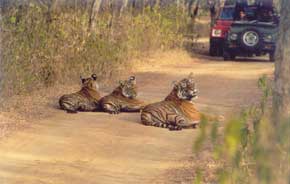 The tiger contest is over and the winners are,
The tiger contest is over and the winners are,
First Prize
Sandy Crooms, 3939 Ross Rd. USA email:
sandyandy1792002@yahoo.com
Second prize
Sherry 600 Church United States Michigan Hudson email:
amberlybowman82@hotmail.com
You can read the winning entries along with the audio visual by
clicking here.
We thank our judge Shekhar Dattatri - well known film maker who produced " Silent Valley-an Indian Rain forest" , "Nagarhole- Tales from an Indian Jungle" and " The Ridley's Last Stand" among others. Shekhar has also, at our request, sent
a short comment on the audio visual .
Shekar Dattatri
Wildlife filmmaker
Plot No.40, Door No.11
3rd East Street, Thiruvanmiyur
Chennai 600 041
Tel: + 91-44-2441 5744 or 2491 4802
Fax: + 91-44-2491 0910 or 2491 8747
Email: dattatri@vsnl.com
December 24, 2003
Comments on the Tiger Caption Contest:
"Humans are often anthropomorphic when judging the actions of animals – ie. we have a tendency to attribute human emotions and motives to animals. This can be misleading when we want to really understand animal behaviour.
The tigers in the movie clip are very obviously a mother and her two large cubs. Rather than doing a "rasta-roko” and trying to stop humans from using the road, or protesting the presence of people in the forest, the tigers are demonstrating
their trust in humans. They are supremely relaxed, and indifferent to the presence of the jeeps and the noisy camera-clicking tourists. They love the dirt road in the forest as it is even and soft, unlike the substrate in the forest where there is leaf litter,
stones, thorns and other pokey things! They seem content, and if at all they are communicating anything, it’s the feeling that all’s well with their world at the moment. "
Thank you to all the participants of the contest!
Indian reptiles
To those of us who have been wishing for more info on Indian snakes on the internet, here is good news. Some very rare and beautiful photographs by Harsha J are uploaded on the site
http://www.indianreptiles.com/. Do have a look.
Online chat
Our monthly online chat on "mangroves of India" could not take place this month as our expert moderator was unavailable. However Mr. Vivek Kulkarni, who has been in the forefront of protecting Mumbai's mangroves, will be available online between
7.30 PM and 8.30 PM on 18th January 2004. So please log in to the chat room and let us have a lively discussion.
After the black out of yahoo groups in India is over, our IndianWildlifeClub yahoo group is active once again. Interesting excerpts from a current topic of discussion can be
read here.
And views……..
Why Protect Biodiversity?
Good ecological and economic practices are two sides of one coin. The globe's food and water securities depends on the protection and wise use of biodiversity. Protecting water sources and soils directly improves the quality of human life.
India is the world's sixth richest nation on the biodiversity scale.
India has been blessed with unimaginable natural wealth - from the frozen frontiers of the Himalaya, rain forests in the Northeast, deserts and grasslands of Kutchh, Saurashtra and Rajasthan, the incredible forests of Satpuras, Western and Eastern Ghats. Equally
impressive are our inland wetlands and brackish water lakes, the coral reefs of the Andaman and Nicobar Islands and Lakshadweep. India is a virtual treasure trove of diverse habitats and landscapes.
Such diversity of habitats not only supports wildlife but also rich natural resources. These forests act as water catchments that help to recharge ground water, support livelihood of millions, act as carbon sinks, provide us with fresh air.
The contribution of these forests is invaluable.
The future of food and fresh water security lies in wise use of these resources.
( Courtesy BNHS Green Governance Programme)